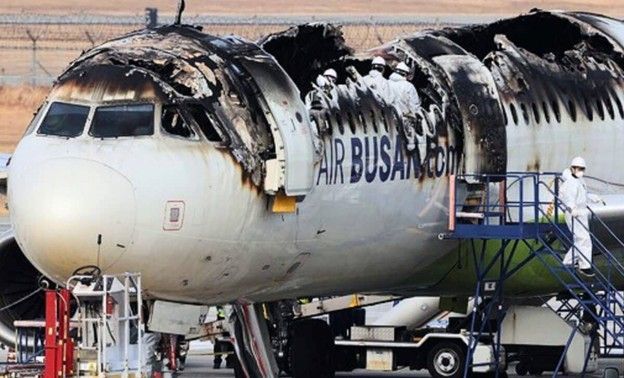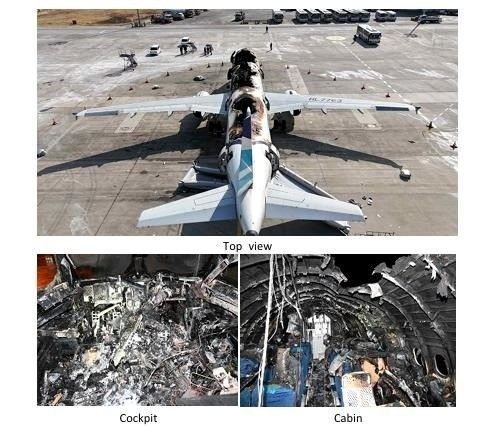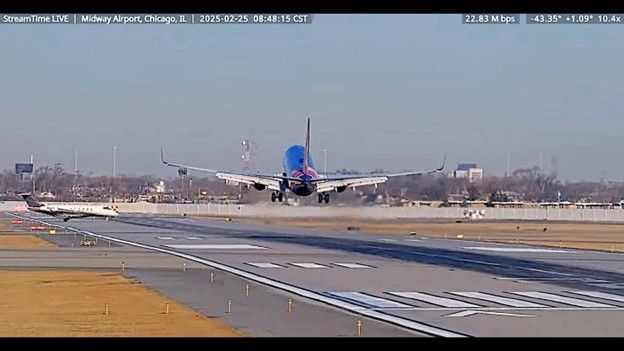ARFF Daily News
Published on:
Tuesday the 4th of March, 2025
Here are today's stories for your reading pleasure...
Of note, more agencies/airlines addressing lithium battery-powered devices in both carry-on and checked luggage as well as the story regarding the comments made by Transportation Secretary Duffy regarding crew errors and pulling certifications. Wonder what may be coming down the pipe for operators of vehicles involved in incursions? Be alert, keep your head on a swivel and get home to your family after your shift!
Be safe out there!
Tom
Terrifying Mid-Air Fire Forces Airlines to Ban This Popular Travel Item – Millions of Passengers Affected
Airlines are quietly cracking down on a popular travel gadget after a terrifying mid-flight fire forced an emergency evacuation. New restrictions are rolling out soon, with some carriers imposing outright bans.
Arezki AMIRI
More airlines are tightening restrictions on power banks after a dramatic mid-air fire prompted an emergency evacuation.
The incident, which took place in January aboard an Air Busan flight, was caused by a power bank that ignited in an overhead bin, severely damaging the aircraft.
Thankfully, all passengers were safely evacuated, but the scare has pushed multiple airlines to reevaluate their policies on lithium battery-powered devices in both carry-on and checked luggage.
Air Busan Bans Power Banks Entirely
In response to the fire, Air Busan has taken one of the strictest stances in the industry by banning power banks on all flights. This sweeping measure aims to eliminate any risk of lithium battery-related incidents.
Eva Air and China Airlines Introduce New Restrictions
Starting March 1, 2025, Eva Air and China Airlines will enforce stricter regulations on power banks. Eva Air will prohibit passengers from using or charging power banks during flights.
Additionally, spare lithium batteries and power banks will not be allowed in checked luggage and must be carried in the cabin with precautions to prevent compression or damage.
Australia’s Already Tough Rules on Power Banks
Australian airlines have long had strict guidelines on lithium batteries and power banks.
Qantas bans luggage with non-removable lithium batteries and requires passengers to keep power banks out of checked baggage. Any detached power banks must be carried in carry-on luggage.
Virgin Australia follows similar protocols, requiring all spare batteries, including power banks, to be stored in carry-on baggage with protective measures to prevent short circuits.
The Virgin Australia website says: “Spare/loose batteries (including power banks/packs must be in carry-on baggage only and must be protected against short circuit by, placing in its original retail packaging, placing each battery in a separate plastic bag or protective pouch or insulating terminals by taping over exposed terminals.”
Growing Concerns Over Lithium Battery Fires
Fires caused by lithium batteries on aircraft are a growing safety concern. These batteries, which power everything from laptops to portable chargers, can overheat and catch fire if damaged, overcharged, or subjected to pressure changes.
With travelers increasingly reliant on portable electronics, airlines are expected to introduce even stricter measures in the near future. To avoid travel disruptions, passengers should check their airline’s specific power bank policies before heading to the airport.
https://en.econostrum.info/au/terrifying-mid-air-fire-forces-airlines-to-ban-this-popular-travel-item/


Duffy Says Pilot Blunders Should Result In Loss Of Certificate
Transportation Secretary Sean Duffy say pilots whose errors result in incidents should have their certificates pulled.
Russ Niles
Transportation Secretary Sean Duffy has doubled down on a threat to "pull" the certificates of pilots found to blame for causing aircraft incidents. In the aftermath of a tight runway incursion at Chicago Midway last week, Duffy posted on X that it is “imperative that pilots follow the instructions of air traffic controllers. If they do not, their licenses will be pulled.” It's not clear if that means revoking certificates or suspending them. The crew of a Flexjet Challenger 350 had been told to hold short for a Southwest flight landing and read back the instruction but crossed anyway, forcing the 737-800 to go around.
On Friday, Duffy emphatically repeated the threat. When asked by NBC Nightly News if that was still his position he replied "Hell, yes," , accompanied by a gesture mimicking an umpire ejecting a player from a ball game. Revocations are currently reserved for egregious violations that have contempt for the rules and a disregard for safety at their heart. Although the circumstances of all incidents are different, a typical sanction for this kind of transgression would be remedial training and possibly a fine. A certificate suspension could also be imposed. The pilots could fight the sanctions before an NTSB judge.
Meanwhile, AOPA would also like to clarify Duffy's intent. "Transportation Secretary Duffy 's comments about "pulling" a pilot's license if they don't follow ATC instructions ignores the importance of due process and the wide spectrum of scenarios where an alternative remedy would be more appropriate in our collective pursuit of safety. We look forward to working with Secretary Duffy and the FAA to define the specifics of his comments," AOPA President Darren Pleasance said in a statement to AVweb.
https://www.avweb.com/aviation-news/duffy-says-pilot-blunders-should-result-in-revocations/?MailingID=FLY250303002&utm_campaign=avwebflash&utm_medium=newsletter&oly_enc_id=3681J3205156A2X

NTSB Final Report: Aero Vodochody L-39ZA
Total Loss Of Engine Power Due To Water-Contaminated Fuel From An Undetermined Source
Location: Barnhart, Texas Accident Number: WPR23LA183
Date & Time: May 2, 2023, 16:10 Local Registration: N343WT
Aircraft: Aero Vodochody L-39ZA Aircraft Damage: Substantial
Defining Event: Fuel contamination Injuries: 2 None
Flight Conducted Under: Part 91: General aviation - Personal
Analysis: The pilot stated that after taking off and climbing through about 7,300 ft mean sea level (msl), he heard a “pop” noise. He scanned the engine instruments and saw them “rolling back.” The pilot pitched the airplane for best glide and attempted to restart the engine, which was unsuccessful. Unable to restart the engine, the pilot performed a forced landing to a dirt road in a field, which resulted in substantial damage to both wings. The pilot reported that he had flown to the departure airport the day before the accident, had the airplane refueled with 342 gallons of fuel, and had the airplane secured in a hangar before taking off for the accident flight.
A postaccident examination of the airplane and engine revealed no mechanical anomalies with the engine or airframe that would have contributed to a loss of engine power. Fuel recovered from the airplane fuel sump after the accident was tested for contaminants. Water was detected in that fuel sample at a rate of 55 parts per million (ppm), which is considered an acceptable level. However, recovery personnel stated that when the airplane was de-fueled during the recovery process, the ½ gallon capacity fuel-water separator filter clogged and filled with water 3 times. The recovery personnel further stated the airplane had not been rained on after the accident and before recovery.
Fuel was tested from the source where the airplane was refueled before the accident flight and water was detected at less than 15 ppm and no fuel related issues were reported by the operators of the other aircraft refueled from the same source.
Fuel is capable of absorbing water directly from the atmosphere via the ventilation system of the fuel system/storage tank or through condensation in the tank. However, investigators were not able to verify if that occurred.
The circumstances of the accident, coupled with the finding of undissolved water in the fuel during the recovery of the airplane, is consistent with a total loss of engine power due to fuel contamination. However, the source of the water in the fuel could not be determined based on available evidence.
Probable Cause and Findings: The National Transportation Safety Board determines the probable cause(s) of this accident to be -- A total loss of engine power due to water-contaminated fuel from an undetermined source.
FMI: www.ntsb.gov

Today in History
63 Years ago today: On 4 March 1962 Caledonian Airways flight 153, a Douglas DC-7, crashed shortly after takeoff from Douala Airport, Cameroon, killing all 111 occupants.
Date: Sunday 4 March 1962
Time: 18:21
Type: Douglas DC-7C
Owner/operator: Caledonian Airways, lsf Sabena
Registration: G-ARUD
MSN: 45160/754
Year of manufacture: 1957
Total airframe hrs: 14548 hours
Engine model: Wright R-3350
Fatalities: Fatalities: 111 / Occupants: 111
Other fatalities: 0
Aircraft damage: Destroyed, written off
Category: Accident
Location: 2,5 km E of Douala Airport (DLA) - Cameroon
Phase: Initial climb
Nature: Passenger - Non-Scheduled/charter/Air Taxi
Departure airport: Douala Airport (DLA/FKKD)
Destination airport: Lisboa-Portela de Sacavém Airport (LIS/LPPT)
Confidence Rating: Accident investigation report completed and information captured
Narrative:
Caledonian Airways flight 153, a Douglas DC-7, crashed shortly after takeoff from Douala Airport, Cameroon, killing all 111 occupants.
The heavily-laden DC-7 was making a night takeoff from Douala runway 12 in conditions of high ambient temperature and humidity. After a long takeoff from the 9350 feet long runway, it gained little height. Some 2300yds from the runway end, 500yds left of the extended centreline, the left wing struck trees 72 feet above aerodrome elevation. The DC-7, named "Star of Robbie Burns", crashed into a tidal swamp and exploded on impact.
The flight, a special charter flight on behalf of Trans Africa Air Coach of London, had departed Luxembourg (LUX) on March 1, 1962, arriving in Lourenço Marques (now Maputo), Mozambique on March 2.The flight left again on March 4, bound for Douala (DLA), Cameroon, Lisbon (LIS), Portugal and Luxembourg.
PROBABLE CAUSE: "In spite of the very numerous expert examinations and all the tests on the ground and in flight which the Commission of Inquiry has carried out or caused to be carried out, the state of the wreckage and its position in an inundated forest area have prevented the Commission from determining with absolute certainty the cause of the accident to DC-7C G-ARUD. The commission considers, however, that there is evidence to show that an elevator spring-tab mechanism may have jammed before impact. This jamming would have resulted in abnormal elevator control forces during the takeoff. Flight tests have shown this to be consistent with a prolonged takeoff run and a risk of losing height during flap retraction. Furthermore, the following features, all adverse, may have aggravated the circumstances in which the accident occurred: - the implementation of a procedure for gaining speed which was conducive to the aircraft being flown at a low altitude - the fact that a positive rate of climb was not maintained at the time of flap retraction which, in the SABENA procedure applied by Caledonian Airways, is not subject to any altitude limitation other than that of obstacle clearance - the presence in the co-pilot's seat of a check pilot whose attention may have been attracted more by the actions of the first pilot than by the indications on his own instrument panel. The Commission had been unable to eliminate an instrument failure as a possible cause of the accident, as the instruments were not recovered or were too seriously damaged to allow of any valid expert examination."

